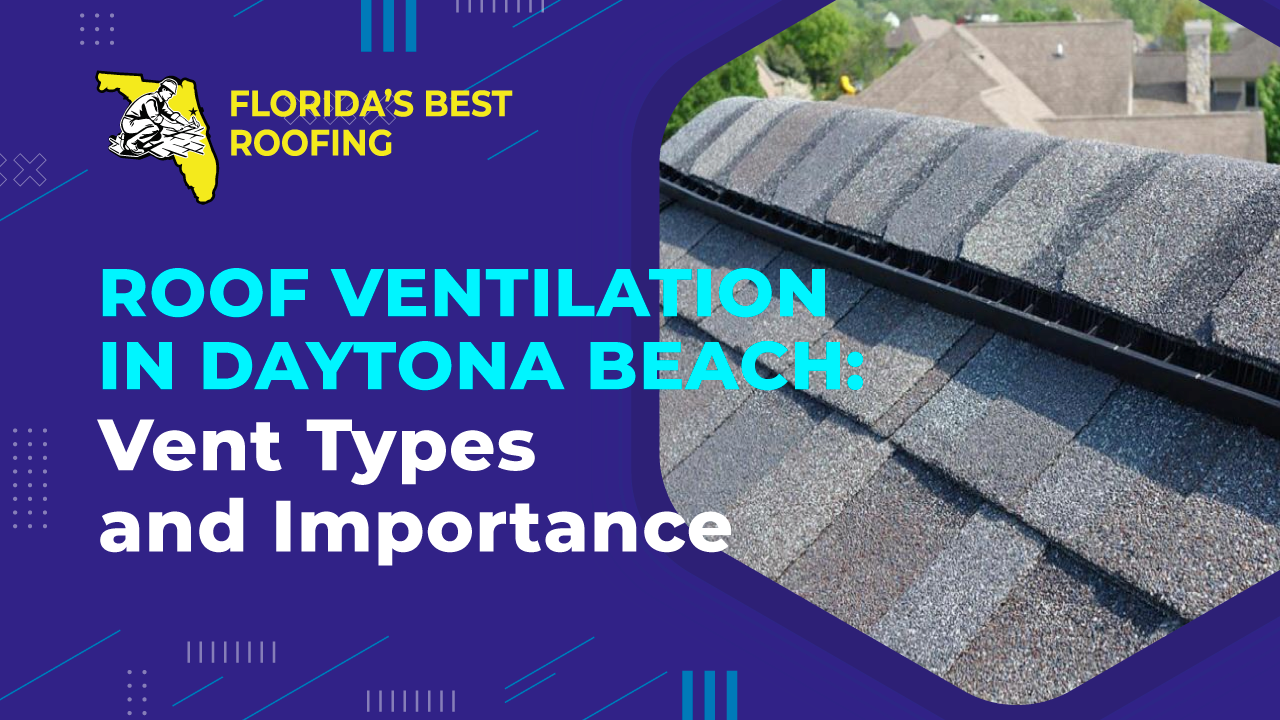Roof Ventilation in Daytona Beach: Vent Types and Importance
Why does a roof require vents, and why are there different types of vents? Here, we will explore the importance of roof ventilation, the types of vents, and the pros and cons of each.
Good ventilation systems extend the lifetime of the roof and can reduce the energy consumption and cost of the structure. There are two types of ventilation: exhaust (letting out stale air) and intake (bringing in fresh air). Ideally, a roof will have both types of ventilation, but occasionally the architecture of the home will allow only for exhaust, not intake. Although having both is best, just exhaust is better than nothing at all.
Why is exhaust ventilation important? Hot air rises and contains moisture, which is a significant issue, especially in warm climates like Florida. If hot, moist air is allowed to stagnate in the attic, it will lead to mildew and mold problems, compromising the wood framing and decking of the roof. To prevent this, exhaust vents are installed at the top of the roof, most often on the ridges, to release this hot air.
Why is intake ventilation important? Intake ventilation helps by pushing cooler air in to replace the hot air that rises and exits through the exhaust vents. Intake vents are installed along the eaves of the roof, usually in the soffit, to take in cool air and push the hot air up through the exhaust vents.
Unventilated or improperly ventilated roofs can lead to major, expensive problems such as poor indoor air quality, overburdened air conditioning systems, moisture in the attic space, and dry rot of roof sheathing. In colder climates, ice dams can form on roofs in the winter months, straining the roof framing and wearing down the roofing material.
Types of Exhaust Vents
Ridge Vents: These are the most common and effective type of exhaust vent. They are installed across the peak or ridge of a roof, allowing the rising hot air to exit out of the highest point. Ridge vents usually run across the entire peak of the roof, providing maximum surface area for the hot air to escape. Ridge vents come in two main types: aluminum and shingle-over.
Off Ridge Vents: These vents are smaller than ridge vents, typically varying in size from 2 feet to 8 feet, with the most common type being 4 feet across. They are installed about one foot below the ridge line and are less effective than ridge vents due to their smaller surface area.
Box Vents: Also known as turtle vents, these are square vents, usually sized 18 inches by 18 inches. They are installed in bunches on roofs with short ridges or as auxiliary vents in areas that require ventilation but are not suitable for ridge or off ridge vents.
Hard-Wired Powered Attic Vents: These are electric fans that pull stale air out of the attic space. They are hard-wired into the home’s electrical system and rely on it for their function. While they provide some exhaust ventilation, their constant use of electricity increases the home’s electric bill. They can also pull cooler air from the house’s interior, raising AC costs.
Solar Powered Attic Vents: These are similar to hard-wired power vents but are powered by a solar panel attached to the vent. This removes the increased electricity cost but does not eliminate other issues. Like hard-wired power vents, they are often either too powerful or not powerful enough to function efficiently with the roof’s ventilation system.
Roof Turbines: These devices consist of aluminum blades within an aluminum cowl that rotate due to wind movement, pulling air from the attic. They are eco-friendly and quiet but require winds of at least 5 or 6 mph to function properly. Multiple units are needed to ventilate a whole roof.
Cupola Vents: Cupola vents are unique, rare, and expensive but often quite beautiful, adding to a home’s aesthetic. They were originally created to allow a lot of air into a barn to help dry hay and other crops. They act as both exhaust and intake vents and come in many shapes and sizes with elaborate decorative features.
Types of Intake Vents
Soffit Vents: This is the most common and effective type of intake ventilation. Soffit vents are installed directly on the eaves of the roof to provide continuous ventilation around the roof’s perimeter. They are typically made of vinyl or aluminum and can be continuous or individual.
Gable Vents: These are usually round or triangular vents just below the peak of a roof’s gable. They function partially as intake and partially as exhaust vents in a horizontal cross-ventilation system. This system is less effective than the vertical cross-ventilation of soffit and ridge vents.
Over Fascia Vents: These vents are placed at the top of the fascia board and below the first row of wood covering. They are less effective than soffit vents because the intake surface area is decreased. However, they are useful when the eaves’ overhang does not allow for soffit venting.
Drip Edge Vents: Similar to over fascia vents, these are either part of or added to the roof’s drip edge. The drip edge is a metal strip attached at the edge of the roof to direct water drainage off the side or into the gutters.
We hope this post has shown you the ins and outs of roofing ventilation. For all your roofing needs in Flagler, Palm Coast, Bunnell, Daytona Beach, and Deland, call Florida’s Best Roofing at 386-263-7906 for a free estimate!
#RoofVentilation #ExhaustVents #IntakeVents #RoofingTips #HomeMaintenance #FloridaRoofing #EnergyEfficiency












